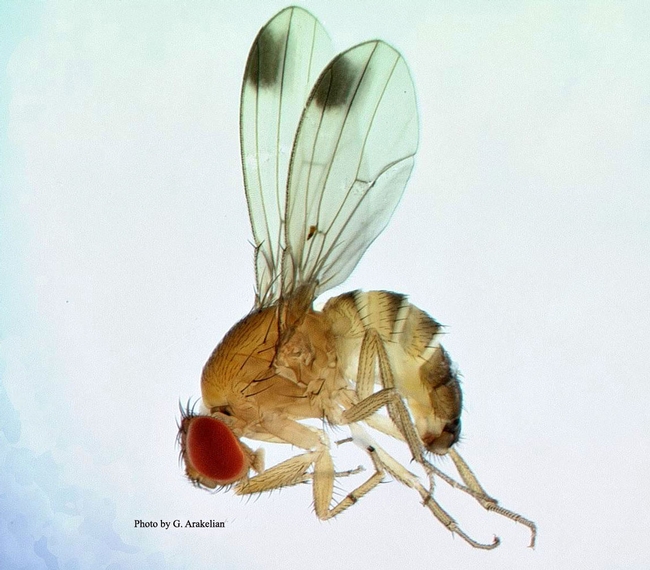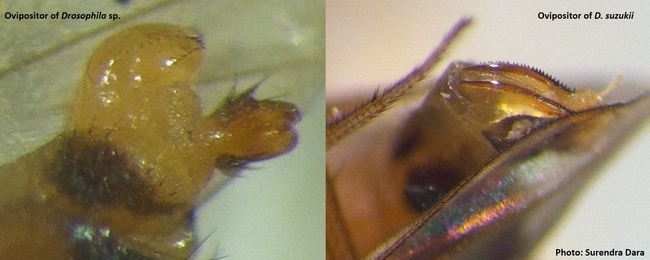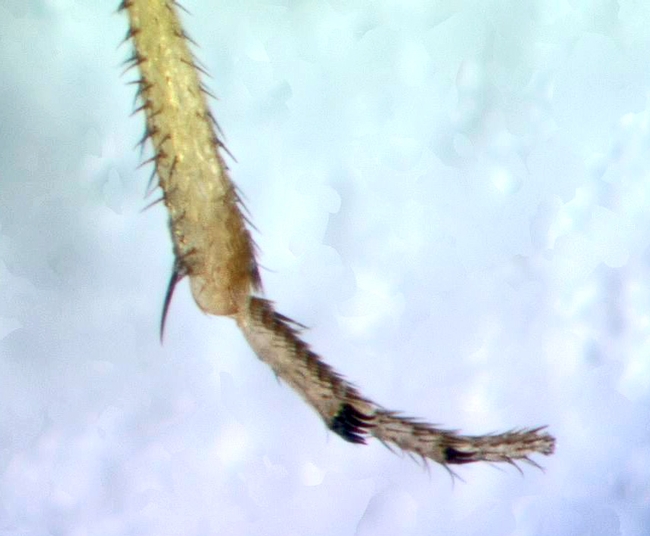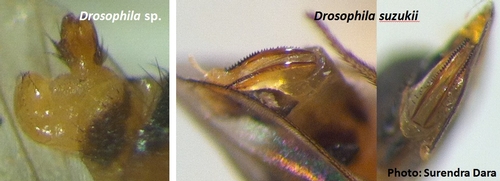- Author: Surendra K. Dara
Male spotted wing drosophila adult. Photo by Gevork Arakelian, Los Angeles County Ag Commissioner's Office
Spotted wing drosophila (SWD), Drosophila suzukii is a pest of several small fruit in California and other states. SWD belongs to the group of flies that are generally known as vinegar flies or lesser fruit flies. It was initially known as cherry fruit fly in 1930s and is now referred to as spotted wing drosophila. SWD can be distinguished from other Drosophila spp. based on the following traits:
- Females have a hard and dark (sclerotized) ovipositor with prominent serrations or saw-teeth that enable the fly to lay eggs in intact ripening fruit.
- Antennae with branched bristle-like part called arista.
- Males have a distinctive dark spot at the tip of each wing.
- Males also have two dark bands (combs) of 3-6 teeth on each front leg.
Sclerotized ovipositor of SWD (right) compared to the normal ovipositor of a vinegar fly (left).
Distinctive combs on the front legs of male spotted wing drosophila. Photo by Gevork Arakelian.
Origin and distribution: It is traditionally known to be a pest in Asia, but it is now reported in Neotropics, North America, and Europe. In the US, it has been reported in Hawaii, Washington, Oregon, California, Utah, Minnesota, Michigan, Missouri, Louisiana, West Virginia, Pennsylvania, North Carolina, South Carolina, and Florida.
Host range: They generally infest thin-skinned fruit and prefer temperate climate. Host range includes apple, blackberry, blueberry, cherry, dogwood, grape, mulberry, peach, persimmons, plum, raspberry, and strawberry. Non-crop hosts that support SWD populations include barberry, brambles (wild raspberry and blackberry), buckthorn, cotoneaster, currant, dogwood, elderberry, fig, honeysuckle, laurel, mulberry, nightshade, oleaster, orange jasmine, pin cherry, pokeweed, purple flowering raspberry, spicebush, sweet box, and yew.
Biology: SWD prefer 68-86 oF and overwinter as adults. Various sources suggested 5-10 generations per year. Eggs are translucent to milky-white. Females lay an average of 384 eggs at 7-16 per day and there can be 1-3 eggs per oviposition site. Multiple females may deposit eggs in the same fruit. Eggs hatch in 2-72 hours and larval stage lasts for 3-13 days. Larvae milky-white with a legless body tapering towards the anterior end (towards the head). Mouthparts are dark and sclerotized. Pupation takes place inside the fruit or in the soil and lasts for 3-15 days. Pupae are reddish brown and have two spiracles (breathing tubes) at the anterior end. Adults are small (2-3 mm) flies. Life cycle takes anywhere from 21-25 days at 59 oF to 7 days at 82 oF. Females can start laying eggs within 1 day after their emergence and can lay more than 400 eggs in their lifetime. Based on the degree day (DD) calculations, egg, larval, and pupal stages require 20.3, 118.1, and 200 DD.
Damage: Other fruit flies usually infest overripe and fallen fruit, but SWD infests fresh fruit because of its powerful ovipositor. Adults feed on fallen fruit but lay their eggs under the skin of intact fruit. Softening and collapse of the tissue results from larval feeding inside the fruit. Oviposition holes can be seen on the fruit with close observation. In addition to the direct damage, SWD makes the infested fruit vulnerable to other pests and diseases. Monitoring SWD is very important to avoid harvesting and marketing infested berries.
Monitoring: Use traps made with apple cider vinegar or yeast-sugar solutions for early detection of SWD. There are numerous studies using a variety of containers and attractants. Pherocon traps and lures are commercially available for SWD monitoring.
Management: A variety of organic and conventional management options are available.
Cultural – Discard fallen and unmarketable fruit in the field to prevent infestation. Remove wild hosts in the vicinity that might harbor SWD populations.
Botanical – Pyrethrins and azadirachtin products are used in multiple studies.
Chemical – Research indicates that organophosphates, pyrethroids, and spinosyns are among the chemicals that can be used against SWD. Remember to rotate chemicals among different mode of action groups to reduce the risk of resistance development.
Microbial – Entomopathogenic fungi (Beauveria bassiana or Isaria fumosorosea) and bacteria-based products such as Grandevo (Chromobacterium subtsugae) and Venerate (Burkholderia rinojensis) against adults, and entomopathogenic nematodes (Heterorhabditis spp. and Steinernema spp.) against pupae that form outside the fruit can be used.
Additional resources:
http://ipm.ucanr.edu/PMG/PESTNOTES/pn74158.html
http://www.omafra.gov.on.ca/english/crops/facts/swd-wildhosts.htm
http://www.ipm.msu.edu/uploads/files/SWD/em9113.pdf
http://entnemdept.ufl.edu/creatures/fruit/flies/drosophila_suzukii.htm
http://pest.ceris.purdue.edu/map.php?code=IOAPAUA
http://www.ipm.msu.edu/invasive_species/spotted_wing_drosophila/factsheets
- Author: Surendra Dara
Spotted wing drosophila (SWD), Drosophila suzukii has become a potential concern for strawberries following its damage to cherries, blackberries, raspberries, and blueberries in coastal California. Other species of Drosophila are morphologically not equipped to attack ripening strawberries. Their ovipositors or egg laying parts are not strong enough to penetrate unripe or ripening berries. They may damage overripe strawberries left on the crop, but since such berries are not marketed, they have not been an issue for growers. However, SWD has a heavily sclerotized, serrated ovipositor that enables it to lay eggs in fruits that are not fully ripe.
In response to the concern that SWD could be a potential pest to strawberries, I monitored some fields in Santa Maria last year. Five fields – four conventional and one organic – in various parts of Santa Maria were monitored for five months from March to July, 2011. Two kinds of traps, one with apple cider vinegar and the other with yeast-sugar extract were used in each location and were observed every week. During this monitoring there were no signs of SWD in any of these traps. However, I recently received some specimens from a Santa Maria grower in which I found what seemed to be the females of SWD among other Drosophila sp. There were no males with their obvious characteristic of spotted wings, but the following and other characters of the females suggest these were SWD:
- Hard and dark (sclerotized) ovipositor with prominent serrations or saw-teeth that enable the fly to lay eggs in intact ripening fruit.
- Antennae with branched bristle-like part called arista.
According to Dr. Brian Cabrera, Santa Barbara County Ag Commissioner Entomologist, there haven't been any SWD infestations that were brought to his attention. So, it appears to be the first report of SWD in Santa Maria strawberries. Sanitation, trapping, and chemical control are among the available options to manage SWD. Close monitoring is necessary in vulnerable areas. More details about identifying and managing SWD can be found in the listed references. Here is a brief note about this pest.
SWD belongs to the group of flies that are generally known as vinegar flies or lesser fruit flies. It was initially known as cherry fruit fly in 1930s and is now referred to as spotted wing drosophila.
Origin and distribution: It is traditionally known to be a pest in Asia, but it is now reported in Neo Tropics, North America, and Europe. In the US, it has been found in Hawaii, Washington, Oregon, California, and Florida.
Host range: They generally infest thin-skinned fruit and prefer temperate climate. Host range includes apple, blackberry, blueberry, cherry, dogwood, grape, mulberry, peach, persimmons, plum, raspberry, and strawberry.
Biology: SWD prefer 68-86 oF and overwinter as adults. Various sources suggested 5-10 generations per year. According to Kanzawa (1939) egg laying starts in spring and can last for 10-59 days. Females lay an average of 384 eggs at 7-16 per day. Eggs hatch in 2-72 hours and larval stage lasts for 3-13 days. Pupation takes place inside the fruit or in the soil and lasts for 3-15 days. Life cycle takes anywhere from 21-25 days at 59 oF to 7 days at 82 oF.
Damage: Other fruit flies usually infest overripe and fallen fruit, but SWD infests fresh fruit because of its powerful ovipositor. Adults feed on fallen fruit but lay their eggs under the skin of intact fruit. Softening and collapse of the tissue results from larval feeding inside the fruit. Oviposition holes can be seen on the fruit with close observation. In addition to the direct damage, SWD makes the infested fruit vulnerable to other pests and diseases. Monitoring SWD is very important to avoid harvesting and marketing infested berries.
Maggots (of unknown species) in infested fruits showing up in processed strawberry container. Photo by Surendra Dara
http://ucanr.edu/articlefeedback
References
Calabria G., J. Máca, G. Bächli, L. Serra and M. Pascual. 2012. First records of the potential pest species Drosophila suzukii (Diptera: Drosophilidae) in Europe. J. Appl. Entomol. 136:139-147.
Kanzawa, T. 1939. Studies on Drosophila suzukii Mats. 49 pp. (http://www.cabdirect.org/abstracts/19410501073.html;jsessionid=81E9221496390100F7C13052E18F8079)
http://www.agf.gov.bc.ca/cropprot/swd_identification.pdf
http://www.al.gov.bc.ca/cropprot/swd.htm
http://entnemdept.ufl.edu/creatures/fruit/flies/drosophila_suzukii.htm
http://www.freshfromflorida.com/pi/pest-alerts/drosophila-suzukii.html
http://www.ipm.ucdavis.edu/EXOTIC/drosophila.html










